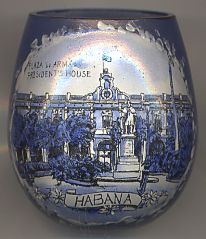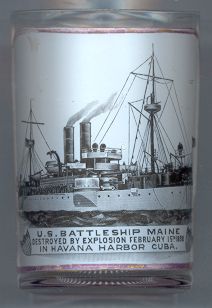

|
| CUBA | |
| Ciudad de La Habana |
San Cristóbal de La Habana is the capital of Cuba and with a population of about 2.1 million the largest city in the Caribbean.
Havana was originally founded in 1515 by conquistador Diego Velázquez de Cuéllar as the first town on Cuba on the southern coast of the island. Already four years later the settlement was moved to its current location on the northern coast. It was originally a trading port but suffered from beind burnt by buccaneers in 1538, and looted in 1553 and 1555. Great Britain seized the city in 1762, but exchanged it for Florida the following year. In 1607 it became the capital of the Spanish colony of Cuba, and also became the main port of the Spanies colonies in the New World and the most heavily fortified city in the Americas. The colony's struggle for independence started in 1868 and continued during the 19th century until the Spanish–American War of 1898. The United States occupied the island until its independence was granted in 1902, though limited by the Platt Amendment (revoked in 1934), after which the US continued to have a major influence in Cuban affairs. In the 1920's, during the Prohibition in the United States, it became a popular vacation destination for Americans. Most of the nightclubs and gambling clubs were closed during the 1959 Cuban Revolution led by Fidel Castro. The old town of Havana and its fortifications preserve a wealth of Spanish Colonial architecture and were listed in 1982 as a UNESCO World Cultural Heritage site. (see also list of other UNESCO heritage sites depicted on glasses of this collection)

 Palacio de los Capitanes Generales is the former official residence of the governors (Captains General) of La Habana.
Located on the eastern side of the Plaza de Armas in Old Havana it is home to the Museum of the City of Havana (Museo de la Ciudad).
It houses exhibitions of art and historical artefacts and many of the rooms are preserved with their original Colonial decoration.
The plan for the building was put forward to the city council already in 1773 but it took until 1792 to complete the building.
The building originally housed the governor's residence and a prison, as well as being used as the meeting place for the city council,
as the original council offices in Plaza San Francisco had been badly damaged by a hurricane in 1768. The prison, located in the west wing, was closed in 1834.
The last of the Colonial governors vacated the palace in 1898 when Cuba gained independence under the terms of the Treaty of Paris (1898),
and it was used by the US military governors from 1899 until 1902. It was used as the presidential palace of the Cuban Republic from 1902 until 1920,
when the president relocated to the building which now houses the Museum of the Revolution, and the Palacio de los Capitanes Generales became once again the offices
of the city council. The municipal authorities moved elsewhere in 1967 and in 1968 the palace became the City Museum.
Palacio de los Capitanes Generales is the former official residence of the governors (Captains General) of La Habana.
Located on the eastern side of the Plaza de Armas in Old Havana it is home to the Museum of the City of Havana (Museo de la Ciudad).
It houses exhibitions of art and historical artefacts and many of the rooms are preserved with their original Colonial decoration.
The plan for the building was put forward to the city council already in 1773 but it took until 1792 to complete the building.
The building originally housed the governor's residence and a prison, as well as being used as the meeting place for the city council,
as the original council offices in Plaza San Francisco had been badly damaged by a hurricane in 1768. The prison, located in the west wing, was closed in 1834.
The last of the Colonial governors vacated the palace in 1898 when Cuba gained independence under the terms of the Treaty of Paris (1898),
and it was used by the US military governors from 1899 until 1902. It was used as the presidential palace of the Cuban Republic from 1902 until 1920,
when the president relocated to the building which now houses the Museum of the Revolution, and the Palacio de los Capitanes Generales became once again the offices
of the city council. The municipal authorities moved elsewhere in 1967 and in 1968 the palace became the City Museum.
[Text adapted from http://en.wikipedia.org/wiki/Palacio_de_los_Capitanes_Generales]

The  USS Maine [left], a 6,682-ton second-class battleship of the United States Navy,
was originally designated as Armored Cruiser #1. Congress authorized her construction in 1886 and the ship was launched on November 18, 1889.
Commissioned in 1895 she spent her duty along the U.S. east coast and in the Caribbean. In January 1898 the Maine was sent to Havana
to protect U.S. interests during a time of insurrection and civil disturbance. Three weeks later, on the evening of February 15, the ship was sunk by
an explosion. Although the exact cause is still debated, it was reported at the time
that a Spanish naval mine caused the explosion. The tragedy was the precipitating incident which caused the Spanish–American War that
began in April of the same year and which resulted in the United States of America gaining control over the former colonies of Spain in the
Caribbean and Pacific. On August 5, 1910, Congress authorized the raising of the Maine. On February 2, 1912, she was refloated and towed out to
sea where she was sunk in deep water in the Gulf of Mexico on March 16, 1912. There is a memorial to the 266 men who died at the
Arlington National Cemetery, Virginia.
USS Maine [left], a 6,682-ton second-class battleship of the United States Navy,
was originally designated as Armored Cruiser #1. Congress authorized her construction in 1886 and the ship was launched on November 18, 1889.
Commissioned in 1895 she spent her duty along the U.S. east coast and in the Caribbean. In January 1898 the Maine was sent to Havana
to protect U.S. interests during a time of insurrection and civil disturbance. Three weeks later, on the evening of February 15, the ship was sunk by
an explosion. Although the exact cause is still debated, it was reported at the time
that a Spanish naval mine caused the explosion. The tragedy was the precipitating incident which caused the Spanish–American War that
began in April of the same year and which resulted in the United States of America gaining control over the former colonies of Spain in the
Caribbean and Pacific. On August 5, 1910, Congress authorized the raising of the Maine. On February 2, 1912, she was refloated and towed out to
sea where she was sunk in deep water in the Gulf of Mexico on March 16, 1912. There is a memorial to the 266 men who died at the
Arlington National Cemetery, Virginia.
Several glasses of this collection show other ships.
![[scale]](lineal.jpg)